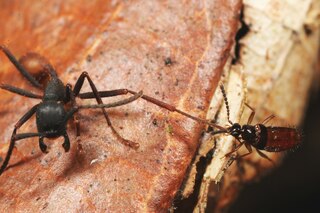
Chipmunks are small, striped rodents of subtribe Tamiina. Chipmunks are found in North America, with the exception of the Siberian chipmunk which is found primarily in Asia.

Genus is a taxonomic rank above species and below family as used in the biological classification of living and fossil organisms as well as viruses. In binomial nomenclature, the genus name forms the first part of the binomial species name for each species within the genus.

Cercis is a genus of about 10 species in the subfamily Cercidoideae of the pea family Fabaceae. It contains small deciduous trees or large shrubs commonly known as redbuds in the USA. They are characterised by simple, rounded to heart-shaped leaves and pinkish-red flowers borne in the early spring on bare leafless shoots, on both branches and trunk ("cauliflory"). The genus contains ten species, native to warm temperate regions of North America, southern Europe, western and central Asia, and China.

The agouti or common agouti is many of several rodent species of the genus Dasyprocta. They are native to Central America, northern and central South America, and the southern Lesser Antilles. Some species have also been introduced elsewhere in the West Indies. They are related to guinea pigs and look quite similar, but they are larger and have longer legs. The species vary considerably in colour, being brown, reddish, dull orange, greyish, or blackish, but typically with lighter underparts. Their bodies are covered with coarse hair, which is raised when alarmed. They weigh 2.4–6 kg (5.3–13.2 lb) and are 40.5–76

Plantaginaceae, the plantain family or veronica family, is a large, diverse family of flowering plants in the order Lamiales that includes common flowers such as snapdragon and foxglove. It is unrelated to the banana-like fruit also called "plantain". In older classifications, Plantaginaceae was the only family of the order Plantaginales, but numerous phylogenetic studies, summarized by the Angiosperm Phylogeny Group, have demonstrated that this taxon should be included within Lamiales.

Cylindropuntia is a genus of cacti, containing species commonly known as chollas, native to northern Mexico and the Southwestern United States. They are known for their barbed spines that tenaciously attach to skin, fur, and clothing. Stands of cholla are called cholla gardens. Individuals within these colonies often exhibit the same DNA, as they were formerly tubercles of an original plant.

Blechnum, known as hard fern, is a genus of ferns in the family Blechnaceae, subfamily Blechnoideae, according to the Pteridophyte Phylogeny Group classification of 2016. Two very different circumscriptions of the genus are used by different authors. In the PPG I system, based on Gasper et al. (2016), Blechnum is one of 18 genera in the subfamily Blechnoideae, and has about 30 species. Other sources use a very broadly defined Blechnum s.l., including accepting only two other genera in the subfamily. The genus then has about 250 species. In the PPG I circumscription, the genus is mostly neotropical, with a few southern African species.

Scolopendridae is a family of large centipedes.

The genus Cathartes includes medium-sized to large carrion-feeding birds in the New World vulture (Cathartidae) family. The three extant species currently classified in this genus occur widely in the Americas. There is one extinct species known from the Quaternary of Cuba.

Hydrochus is the only living genus of beetle in the family Hydrochidae, which belongs to the superfamily Hydrophiloidea, and was formerly treated as a subfamily of Hydrophilidae. Hydrochus includes about 180 species, which are found worldwide. The name "Hydrochus" has also been used for a fly genus in the family Dolichopodidae, but this is a junior subjective synonym of the genus Rhaphium.

The Solanaceae, or the nightshades, is a family of flowering plants that ranges from annual and perennial herbs to vines, lianas, epiphytes, shrubs, and trees, and includes a number of agricultural crops, medicinal plants, spices, weeds, and ornamentals. Many members of the family contain potent alkaloids, and some are highly toxic, but many—including tomatoes, potatoes, eggplant, bell, and chili peppers—are used as food. The family belongs to the order Solanales, in the asterid group and class Magnoliopsida (dicotyledons). The Solanaceae consists of about 98 genera and some 2,700 species, with a great diversity of habitats, morphology and ecology.

Nothodelphax is a genus of delphacid planthoppers in the family Delphacidae. There are more than 20 described species in Nothodelphax.
Rhopalolemma is a genus of cuckoo bees in the family Apidae. There are at least two described species in Rhopalolemma.

Lepidostoma is a genus of bizarre caddisflies in the family Lepidostomatidae. There are more than 150 described species in Lepidostoma.

Phoenicocoris is a genus of plant bugs in the family Miridae. There are about 16 described species in Phoenicocoris.

Tetradonia is a genus of rove beetles in the family Staphylinidae. There are at least three described species in Tetradonia.

Hylesinus is a genus of crenulate bark beetles in the family Curculionidae. There are more than 180 described species in Hylesinus.
Xanthochroina is a genus of false blister beetles in the family Oedemeridae. There are at least three described species in Xanthochroina.
Plagiostira is a North American genus of shield-backed katydids in the family Tettigoniidae. There are at least three described species in Plagiostira. It is the only genus in the monotypic tribe PlagiostiriniStorozhenko, 1994.

Xeralictus is a genus of sweat bees in the family Halictidae. There are at least three described species in Xeralictus.
















